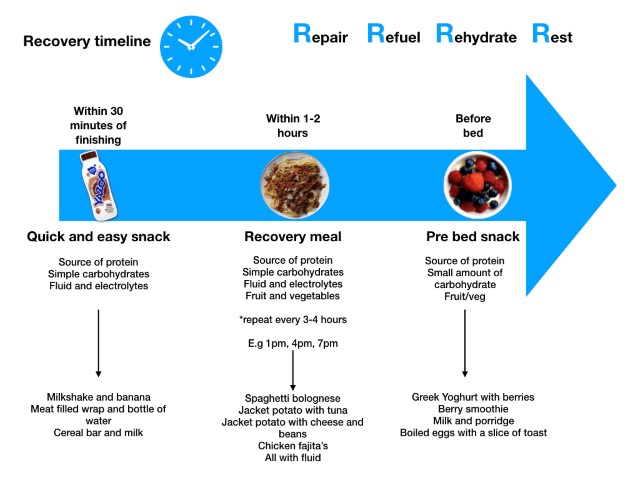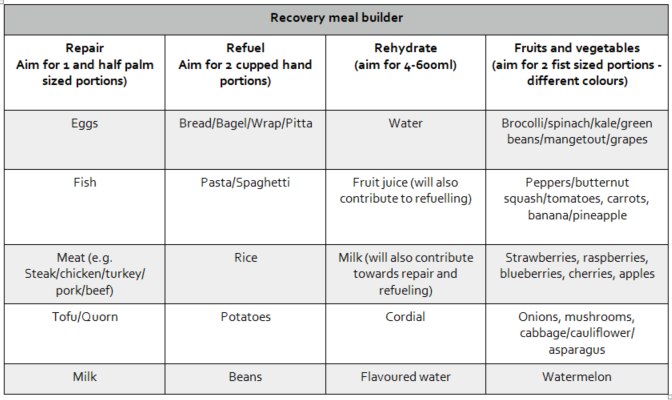By Adrian Hampshire
Question - I coach a U14 and U16 team and want ideas on what kind of foods the players should be eating after training sessions, games and during tournaments to help them recover better?
Effective and efficient recovery from both training and matches is a key part of a young footballer’s development. Maximizing training adaptation and also ensuring that upcoming training sessions or games are performed at the required intensity are key goals of any recovery strategy. For this to occur young players should be instructed to follow the ‘four R’s’ of recovery;
Repair
This can be achieved by consuming foods and fluids rich in protein such as meats, fish, eggs, yoghurt, soya or tofu. The proteins in these foods help repair and growth of muscle tissue which can also aid with increases in strength, speed and power. This is particularly important in development and maturation of young footballers.
Refuel
This can be achieved by consuming foods rich is carbohydrates such as pasta, rice, bread/wraps/bagels, potatoes, sweet potatoes, noodles, fruits, vegetables or oats. Carbohydrates can be stored as something called glycogen in an individual’s muscles. Post exercise carbohydrates can come from a mixture of simple and more complex sources as transportation of these to refill muscle storage is heightened following exercise.
Rehydrate
This can be achieved by consuming adequate fluids and electrolytes accounting for those lost during exercise. Young players will often lose body fluid stores and sodium in their sweat so replacing these is a key part of the recovery process. Usually consuming a food option (which will contain sodium) in addition to drinking fluids such as water is suffice for young players but options such as milk or flavored milk contain both the electrolytes and the fluids.
Rest
This can be achieved by the young player gaining the right quality and quantity of sleep in order to support the recovery process. A sleep duration of 9-10 hours each night is recommended for young athletes and it could be predicted that many do not achieve this. Distractions such as smartphones, gaming and laptops often result in the player staying up late but the light in these devices disrupts the time it takes to fall asleep. Players should avoid this light at the very least 30 minutes prior to sleep. Taking a hot shower just prior to bed is shown to encourage a quicker time to fall asleep so could potentially be done in this time period.
Importance of fruit and vegetables
Fruits and vegetables contain vital vitamins and minerals which help support everyday health. Some are also very important as they contain antioxidants which can aid muscle recovery.
It is often a struggle to ensure that young athletes consume enough fruits and vegetables however can be done with a little creativity. Blending into sauces such as for pasta or implementing in meals such as lasagna or chili con carne may be a way to win the battle with fussier eaters. Some may also respond well to consume frozen fruits in smoothie drinks. Young athletes should aim to ‘eat the rainbow’ meaning a variety of different colored fruits and vegetables each today to consume a variety of vitamins and minerals.

Recovery snack ideas (to be consumed within 30 minutes of finishing a session or game)
• Pint of milk and a banana
• Smoothie - Milk or yoghurt, frozen berries and banana
• Meat filled sandwich or wrap
Recovery meal examples
• Portion size guidance is shown in the table below
1. Chili con carne (Minced beef, bell peppers, onions, canned tomatoes, garlic, kidney beans, mushrooms, beef stock) with rice and a pint of orange cordial.
2. Chicken breast, cod or salmon fillet with sweet potato fries, peas, an orange on the side and a pint of water
3. 2 x Tortilla pizza (wrap as based) with tomato passata, cheese, chicken breast, peppers and spinach. Pint of water
4. 3 egg omelette with ham, mushrooms, spinach and cheese, baked beans a glass of fruit juice
5. Spaghetti bolognese with a side salad and slice of garlic bread. Pint of cordial.
6. Piri -piri or fajita seasoned chicken breast tray bake with butternut squash, potatoes, red and yellow peppers. Glass of fruit juice.
7. Steak, 2 wraps, onions, peppers (fajita) with a pint of water and an orange.
Recovery meal customizer
• Use this table to customize your own recovery meal

Final advice for coaches
Try and keep recovery nutrition simple. Ask the players if they are meeting the 4 x R’s of recovery. If they are having just a bowl of pasta ask how they could improve in order to repair or rehydrate.
If players are really struggling it may be wise to encourage them to make small changes. Using the pasta example it could be that you focus one week on encouraging them to add a protein source to their recovery snack or meal. Once this is achieved they could then add/increase their fluid intake and then their fruit and veg intake.
By Adrian Hampshire
Is a sports nutritionist (MSc Sports & Exercise Nutritionist) and Teacher of Physical Education located in Yorkshire, UK. I provide nutritional support to athletes from a variety of sports in particularly youth, adolescent and scholarship athletes. @adyhamshire


